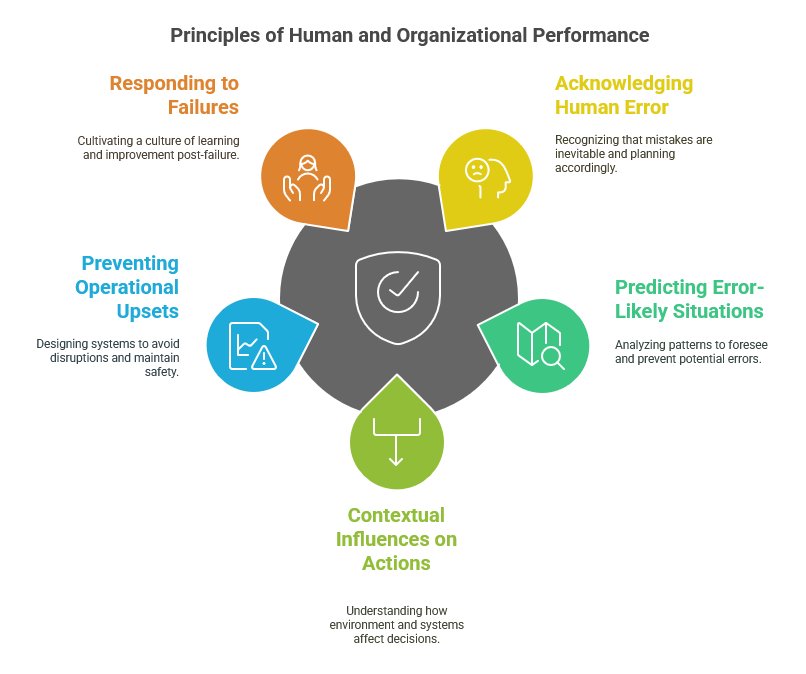The 5 Basic Principles of HOP (Human and Organizational Performance)
July 27, 2021

Conversation is imperative for HOP and most critical to success. Active listening and learning (worker-to-worker and worker-to-management) is necessary to understand where failure and loss is possible.
Human error is inevitable, but it doesn’t have to lead to accidents. Human and Organizational Performance (HOP) offers a proactive approach to safety by addressing human error at its core. By focusing on smarter systems, improved communication, and effective design, HOP helps reduce risks, enhance operational efficiency, and empower employees.
Table of Contents
- Why HOP matters for safety
- Communication is at HOP’s core
- The 5 basic principles of HOP
- Integrating HOP with health and safety management
- How EHS software supports HOP
- Going to good to great in safety
Why HOP Matters for Safety
HOP shifts how organizations approach safety. Rather than blaming human error, it focuses on managing mistakes through better systems and communication.
HOP begins by identifying gaps in safety systems, then closing them through “defenses” (risk-reducing actions), making systems more proactive and resilient.
Communication is at HOP‘s Core
Effective HOP communication goes beyond talking—it’s active listening and learning between workers and management. This feedback loop helps assess past failures, current risks, and future hazards.
The best insights come from frontline workers who face error-prone situations daily. Giving them space to share helps identify potential issues early.
HOP also includes a systems-based approach to safety that uses engineering and management tools to identify, analyze and control risks, not just hazards.
Through this process, human factors are identified and addressed along with any organizational attributes that can threaten defenses and heighten risk.
The 5 Basic Principles of HOP
There are five basic principles that are widely adopted by most HOP practitioners:
1. People make errors: Human error is inevitable. Acknowledging this fact allows organizations to focus on minimizing its impact rather than denying its occurrence.
2. Error-likely situations are predictable: With proper analysis and experience, organizations can predict when and where errors are most likely to occur and take steps to prevent them.
3. All human actions are influenced by the context in which they occur: Performance is not just about the individual—it’s about the environment, systems, and conditions that influence their actions.
4. Operational upsets can be avoided: By anticipating challenges, organizations can design systems to prevent operational disruptions, keeping safety intact.
5. Our response to failure matters: How an organization responds to failure is critical. Shifting from a culture of blame to one of understanding allows organizations to learn and improve continuously.

Integrating HOP with Health and Safety Management
HOP aligns with health and safety management by emphasizing proactive strategies to minimize workplace hazards. By designing systems to manage human error, organizations can reduce risks and improve safety.
In our on-demand webinar, How to Engage Employee Stakeholders, I shared a story about learning the hard way why our response to failure is so important.
As EHS practitioners, we dedicate significant time to shaping organizational culture. However, when we react with blame rather than understanding in the face of failure, we risk eroding workers’ confidence in us.
Adopting Human and Organizational Performance principles increases management and worker participation, helping organizations learn from experiences. By deepening the understanding of risks within the work system, HOP opens the door to more effective control measures. This integrated approach fosters a progressive partnership between management and employees, empowering both to take ownership of safety and health, ultimately reducing the potential for loss.
How EHS Software Supports HOP
Environmental, Health, and Safety (EHS) software is a critical tool for implementing HOP effectively.
EHS software helps organizations make better decisions through:
- streamlined communication, like safety bulletins
- tracking incidents, corrective actions and training
- analyzing data on workplace errors
With real-time monitoring and reporting, companies can use these platforms to identify error-likely situations and respond proactively.
By integrating HOP’s principles into EHS software, businesses can create a culture of continuous improvement, where both management and workers collaborate to enhance safety performance and mitigate risks.
Going from Good to Great in Safety
HOP offers a forward-thinking approach to minimizing workplace hazards by recognizing and managing human error.
Combined with health and safety practices and EHS software, it creates safer, more efficient environments. Embracing HOP drives collaboration, insights, and continuous improvement, making organizations more resilient and safer in the long run.
You can learn more strategies to enhance safety performance with technology by watching our on-demand webinar, Going from Good to Great. Learn how safety technologies – combined with insights from Human and Organizational Performance (HOP) – can help you break down silos, manage risk effectively and achieve lasting safety success.






